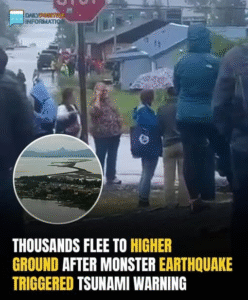A powerful 7.3-magnitude earthquake struck off the coast, triggering a widespread tsunami warning and prompting thousands of Americans to evacuate low-lying coastal areas. The tremor, which hit without much warning, caused panic across several states as emergency sirens blared and local authorities ordered immediate evacuations along vulnerable shorelines. The U.S. Geological Survey reported that the epicenter was located offshore, beneath the ocean floor, at a depth shallow enough to generate dangerous tsunami waves.
The earthquake rattled buildings hundreds of miles from its epicenter and was felt in several major cities. Residents reported shaking that lasted up to a minute in some areas, with items falling off shelves and power outages disrupting services. Emergency response teams were quickly deployed, and local governments activated their disaster preparedness plans.
The National Weather Service’s Tsunami Warning Center issued an urgent advisory minutes after the quake, warning of the potential for destructive waves to strike within hours. Coastal communities in multiple states—including California, Oregon, Washington, and parts of Alaska—were placed under immediate tsunami warning protocols. Evacuation orders were issued in several counties, with officials urging residents to move to higher ground.
Roads and highways saw heavy traffic as people scrambled to leave the danger zones. Emergency shelters were opened, and many schools and public buildings were converted into temporary housing. Authorities emphasized the importance of following official guidance and not returning to coastal areas until an all-clear was issued.
Early estimates suggested waves could reach heights of up to 10 feet in some locations, though wave activity varied by region. In some areas, the ocean receded significantly—often a precursor to an incoming tsunami. Officials urged the public not to approach the shoreline to observe, warning that tsunamis can move faster than people can run.
Seismologists say this earthquake occurred along a well-known fault line with a history of generating large seismic activity. While the quake struck offshore, the magnitude and depth were sufficient to displace a massive volume of water, raising tsunami fears. Aftershocks, some registering above magnitude 5.0, have continued to rattle the region, adding to public anxiety and complicating rescue efforts.
So far, there have been reports of structural damage in coastal towns, including collapsed buildings, fires from gas line ruptures, and flooding in some low-lying areas. No fatalities have been confirmed, but emergency services are combing through affected zones to search for injured or trapped residents. Hospitals have been placed on high alert, and some have already begun treating people for injuries related to the quake.
President and federal emergency officials have been briefed on the situation. The Federal Emergency Management Agency (FEMA) has mobilized resources, with military support on standby for search and rescue operations. In a public statement, national leaders called for calm and solidarity, emphasizing that safety and swift response were the top priorities.
Public schools in several districts announced closures for the following day, and many businesses shut their doors early. Flights in and out of some coastal airports were grounded as a precaution, and ports were temporarily closed to maritime traffic.
Social media platforms were flooded with images and videos showing chaotic scenes—cars bumper-to-bumper during evacuations, people carrying children and pets to safety, and water beginning to flood streets near the shore. Hashtags related to the quake and tsunami trended nationwide as millions sought updates.
Experts have cautioned that tsunami waves can arrive in multiple surges hours apart and that the threat does not end with the first wave. Emergency alerts are being regularly broadcast via TV, radio, and mobile phones to keep the public informed as the situation evolves.
Despite the scale of the disaster, emergency preparedness appears to have saved lives, with many praising the quick response of local authorities and the effectiveness of tsunami alert systems. Still, concerns remain about vulnerable infrastructure and how coastal communities will recover in the days to come.
As night falls, rescue crews continue to work around the clock, using drones, boats, and helicopters to assess damage and reach isolated residents. The full impact of the disaster may not be known for days, but the nation watches anxiously, united in hope and concern for those affected.


